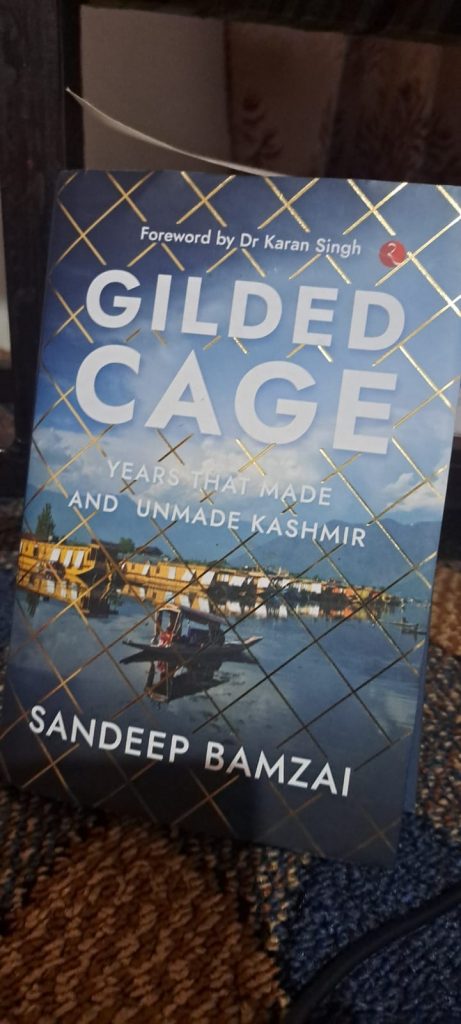
“Gilded Cage: Years That Made and Unmade Kashmir,” a book written by the noted journalist Sandeep Bamzai, highlights and also acknowledges the critical role Sheikh Mohammad Abdullah played in Kashmir’s accession to India. The book, which is the third part of a trilogy following ‘Bonfire of Kashmiriyat’ and ‘PRINCESTAN: How Nehru, Patel and Mountbatten made India.’ A book review
by Riaz Wani
Book name: Gilded Cage: Years That Made and Unmade Kashmir
Author: Sandeep Bamzai
Publisher: Rupa Publications India
Cost. Rs 275
Pages: 140
Sheikh Mohammad Abdullah, also known as Sher-i-Kashmir (Lion of Kashmir) by his admirers in the Valley, has been a very contentious figure who has loomed large over the post-1947 history of the region. His detractors in the now state-turned-union territory accuse him of being primarily responsible for tying the Muslim majority region’s lot with New Delhi in defiance of the logic of Partition whereby Hindu majority regions would become a part of India and Muslim majority areas that of Pakistan. For the past 33 years, his mausoleum at Hazratbal is guarded lest it be subjected to sabotage.
Ironically, Sheikh has now no takers in New Delhi too. In fact, New Delhi is out to erase his name from public memory of Kashmir. Kashmir has already dropped his birth anniversary from the list of public holidays, so has J&K Police his epithet from the title of its gallantry medal. Similarly, Sheikh’s name has been excised from the SKICC that has now become Kashmir International Convention Centre.
But “Gilded Cage: Years That Made and Unmade Kashmir,” a book written by the noted journalist Sandeep Bamzai, highlights and also acknowledges the critical role Sheikh played in Kashmir’s accession to India. The book, which is the third part of a trilogy following ‘Bonfire of Kashmiriyat’ and ‘PRINCESTAN: How Nehru, Patel and Mountbatten Made India,’ Bamzai aims to uncover the real story of Kashmir’s history between 1931 and 1953.
The author challenges the mainstream historical perspective surrounding the events leading up to the abrogation of Article 370 in Jammu and Kashmir. The book chronicles the time from the emergence of Sheikh Abdullah in Kashmir’s politics up to his arrest in 1953 to the disillusionment of the Kashmiri masses with their leadership. It also delves into Pakistan founder Mohammad Ali Jinnah’s efforts to make Kashmir a part of Pakistan and Sheikh antipathy towards him. Similarly, from Jawaharlal Nehru’s comprehension of the Valley being a shop window for his brand of secular politics to Maharaja Hari Singh’s streak of remaining independent in the face of both India and Pakistan, this book covers the vital years that defined Kashmir’s accession to India.
Gilded Cage also offers fresh insights into the lesser-known figures of Ram Chandra Kak and Swami Sant Deo, who played significant roles during this important period.
Bamzai criticizes the Bharatiya Janata Party (BJP) for their attempts to rewrite history and downplay the contributions of Sheikh. The author highlights the role of Maharaja Hari Singh, the last Dogra ruler of Kashmir, and portrays him as a ruler driven by self-preservation. The author, however, credits Maharaja Hari Singh for introducing the state subject ordinance, later enshrined as Article 35A which he hails as a revolutionary legislation.
One of the key figures discussed in the book is Swami Sant Deo, an advisor to Maharaja Hari Singh and a shadowy figure associated with the Rashtriya Swayamsevak Sangh (RSS). Bamzai examines Swami Sant Deo’s influence on the Maharaja’s decision-making process and his vision of an independent Kashmir. The author explores the complex dynamics between Maharaja Hari Singh, Ram Chandra Kak, and Swami Sant Deo, and explains their differing aspirations for Kashmir’s future.
But Bamzai does put Sheikh at the centre of the debate about Kashmir’s accession to India: He spotlights his role in the events of 1947, praises him for his patriotic mindset and his opposition to Jinnah’s thinking. The author credits Sheikh for Maharaja’s accession to India, viewing it as a result of the advice and support provided by him and his party Jammu and Kashmir National Conference.
The book draws on the previously unpublished papers belonging to his grandfather, K.N. Bamzai, a former Delhi bureau chief of ‘Blitz’ who served as Sheikh Abdullah’s private secretary and Officer on Special Duty to Nehru. This privileged access allows for a deeper exploration of the estrangement that unfolded between Nehru and Sheikh in the years following India’s independence.
The book’s achievement is going beyond the familiar narratives surrounding the Kashmir conflict and highlighting the role of external powers such as Britain and the United States. Bamzai presents evidence and documents to support his claims, suggesting that these powers had vested interests in the region and contributed to the subsequent internationalization of the Kashmir issue. The documents and letters add depth to the book, offering readers unique insights into the minds of key figures during the transformative 1947-53 period. The book challenges conventional narratives and prompts readers to reevaluate their understanding of the complex political landscape of Kashmir.
While Bamzai acknowledges the controversial nature of the Modi government’s decision to read down Article 370 in August 2019, he expresses optimism that it will consign the troubled history of Kashmir to the past. He believes the move has helped integrate the region. However, he also expresses the importance of restoring peace in the Valley before expecting Kashmiri Pandits to return to their homeland, emphasizing that the community would not support the creation of a ghetto for them.
However, the author does not fully address the impact of this decision on the Sheikh’s family, with Farooq Abdullah and Omar Abdullah being also arrested under the Public Safety Act. The duo were released months after the withdrawal of Article 370. So were the other senior senior mainstream leaders including the PDP chief Mehbooba Mufti, the People’s Conference chief Sajad Gani Lone and others.
Though an uneasy peace has held in the Valley since the loss of autonomy, people are far from reconciled to the loss of autonomy as a fait accompli. They have been watching the unfolding state of affairs silently. There have been fewer protests and far fewer stone pelting incidents. Hartals are no longer observed. But despite these outward manifestations of peace, the Valley is more alienated than ever. The militancy has suffered a setback but remains very much alive and kicking. It is difficult to predict what the future holds. The situation in Kashmir may have stabilized in the last years but it remains deeply uncertain and far from peaceful.
But ‘Gilded Cage’ is not about the present but the past. It is, however, a piece of the past that relates directly to the present. Article 370 that was withdrawn in August 2019 was agreed to between New Delhi and J&K during the 1947-53 period explored in the book. But whether the repeal of the constitutional provision will end the troubled fallout of this period – as author believes it will – remains to be seen.










